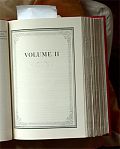
Leo Tolstoy
War and Peace, Volume Two
If Volume One was war than Volume Two must follow with peace. So it begins with peace signed at Tilsit; Napoleon shakes hands with Alexander promising to forego his war-mongering ways. Nikolai Rostov is in the audience when the two emperors symbolically exchange war decorations and finds it more than a little strange:
Why, then, those torn-off arms and legs, those dead people?
The French are assimilated into society and society keeps on moving on (not like that stopped for war).
Life meanwhile, people’s real life with its essential concerns of health, illness, work, rest, with its concerns of thought, learning, poetry, music, love, friendship, hatred, passions, went on as always, independently and outside of any political closeness or enmity with Napoleon Bonaparte and outside all possible reforms.
Volume Two also begins with the intrigues of Pierre’s beautiful wife Hélène and is sandwiched between the intrigues of Natasha. Positioning this volume between these two events seems significant enough to change the definition of peace formed in the first volume. Both states have their lulls and peaks, minor wars and minor peace.
For all her good-looks I find Hélène downright detestable; especially when she is portrayed through the eyes of Pierre who makes no consignations to his distant wife. Instead she functions as a pillar of Society, created by it and only actualized when within it. Every scene of her refers to her marble shoulders, which references me directly to a statue. The intoxication she causes in Natasha at the opera, the will-lessness Natasha has in her presence is similar to how one feels when Society bestows its graces.
Pierre has his metaphysical struggle that towers over all that is Hélène: over the bad society is (according to his own definitions gradually more than the Masons) and good sensations. Pierre is a man who enjoys the fine life and can afford it but is also introspective. He wants to provide education and health and better work conditions for his serfs but can’t pay attention long enough to go through with it. Naturally, the result is discontent and the continuation of the struggle.
Natasha is the lady on center stage, no longer as young as a girl. But the expectations for teenagers was incredible: the pressures of marriage proposals. No wonder women went hysterical or diva, like Hélène, housed up until marriage then housed up again now with kids and cleaning.
Their lack of independence is horribly depressing, having only their “talents” like singing, sewing and the clavichord. Natasha is spirited and pretty, never without admirers even during engagements. If she was alive today, two hundred years later, the embellishments to her character would be endless. Perhaps she would be part of some sub-culture or another, the cute girl with five boyfriends. Instead Natasha gets proposals.
What would that do to your head balanced on the confusion of hormones? If it was up to Natasha she would accept them all then dump them when a suave option comes along. Which she does and seems right in doing, to the shame of her family. The depraved girl. Sonya-the-pure wonders how she can be so finicky, but that’s pretty obvious when looking back from this century.
Anyway, I am happy for this time and choice, for the innumerable steps we now take before marriage.
Having begun Volume Three it’s back to war and the ludicrous Napoleon; back to Leo Tolstoy’s history lessons; back to death and torn-off arms and legs…
· · · · · · · · · · · · · · · · · · · ·